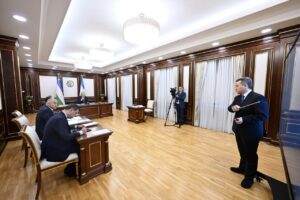
UzTemiRContainer, part of Uzbekistan Temir Yulary, held talks with a number of Asian logistics operators on the development of the China-Kyrgyzstan-Uzbekistan-Afghanistan multimodal corridor on the sidelines of the Investment and Trade Fair in Lanzhou, China.
The meeting was held in a quadrilateral format with the participation of Gansu International Logistics Group, the Afghan diplomatic mission in China, and Xinjiang Union of International Railway Logistics.
The key topics were the launch of return container shipments from Afghanistan and Uzbekistan to China, increasing the route’s capacity, and developing logistics infrastructure in Central Asia, including the construction of terminals in Uzbekistan and Kyrgyzstan.
On the sidelines of the forum, a separate bilateral meeting between representatives of Uztemiryulcontainer and Gansu International Logistics Group took place, during which the parties visited the facilities of the international dry port in Lanzhou.
They inspected container and bulk terminals, car handling areas, and a refrigeration complex for working with refrigerated containers. The delegation from Uzbekistan also familiarized itself with Gansu’s digital solutions in the field of logistics management.
Following the talks, the companies announced the launch of a pilot container route between China, Kyrgyzstan, Uzbekistan, and Tajikistan/Turkmenistan. The first train is scheduled to depart in the third quarter of 2025.
The parties confirmed their intentions to expand cooperation in the field of multimodal transport and expressed their readiness to increase the volume of container transport in the Eurasian direction by at least 1.5 times by 2030.

Foreign Ministers of Uzbekistan, Afghanistan and Pakistan Bakhtiyor Saidov, Amir Khan Muttaki and Ishaq Dar signed a trilateral framework agreement on the development of a feasibility study for the Trans-Afghanistan Railway project during a meeting in Kabul on Thursday.
“We have signed a trilateral framework agreement on the development of a feasibility study for the Trans-Afghanistan-Pakistan Railway project, which is of strategic importance for the whole of Eurasia,” the Uzbek Foreign Minister said in his telegram channel.
He noted that this transportation corridor will improve trade, support Afghanistan’s economic recovery, and open new routes to world markets through southern ports.
According to Saidov, during the meeting, the Uzbek side reaffirmed its commitment to strengthening trade ties, expanding cooperation in agriculture, pharmaceuticals, textiles and construction, as well as increasing the capacity of the Termez International Trade Center (opened in Uzbekistan near the Afghan border).
As reported, in February 2021, representatives of Uzbekistan, Afghanistan, and Pakistan signed a joint action plan for the construction of the Mazar-e-Sharif-Kabul-Peshawar railway with a length of 573 kilometers and a transit potential of up to 20 million tons of cargo per year following talks in Tashkent.
The World Bank, the Asian Development Bank, the European Bank for Reconstruction and Development, the European Investment Bank, the Islamic Development Bank, the Asian Infrastructure Investment Bank, and the U.S. International Development Finance Corporation (DFC) have expressed interest in financing the project.
In April 2024, during Uzbek President Shavkat Mirziyoyev’s visit to Moscow, a preliminary agreement was reached on Russia’s participation in the project. The volume of Russian cargo transportation along the projected route can be estimated at 8-15 million tons annually.
According to the Ministry of Transport of Uzbekistan, the construction of the Trans-Afghan railway line will take at least 5 years, with a preliminary cost of $4.8 billion.
AFGHANISTAN, CONSTRUCTION, PAKISTAN, Trans-Afghan railroad, UZBEKISTAN

On July 1 this year, the President of Uzbekistan watched a presentation of plans in the field of digital technologies, artificial intelligence, and telecommunications.
The number of residents of the IT park of Uzbekistan has exceeded 2800, and the number of foreign companies has reached 752. About 40 thousand young people earn high incomes in this area.
Over the past 5 years, the industry’s exports have grown from $170 million to almost $1 billion.
In 2024, startups attracted $70 million in venture capital investment.
As a result, Uzbekistan has risen 12 positions and entered the top 100 of the global ranking of startup ecosystems. The country also moved up 17 positions in the international AI readiness index, ranking first in Central Asia.
Uzbekistan topped the ranking of CIS countries in terms of the growth rate of the telecommunications industry.
Work in this area is ongoing. In particular, the following goals are set for the next year:
As part of the implementation of these goals, a number of draft regulatory documents have been developed and discussed during the presentation.
To date, 760 types of public services have been digitized. Last year, 10 million citizens used digital services.
Shavkat Mirziyoyev noted that it is time to move on to the next stage – building a Digital Government. First of all, digitalization should cover the most popular areas: education, healthcare, construction, and utilities.
Special attention was paid to the development of artificial intelligence technologies. According to the Presidential Decree of October 14, 2024, the AI development strategy until 2030 was approved. USD 50 million has been allocated for the development of infrastructure in this area.
The goal is to create a national model of artificial intelligence and train 1 million specialists.
The Minister of Digital Technologies reported on the current stages of this task and measures to improve the infrastructure.
Expanding the scope of digital services and export potential remains a priority. So far, the main indicators are concentrated in Tashkent, but thanks to the conditions and benefits created in the country, interest from foreign specialists and companies is growing.
In this context, the President emphasized the importance of creating an attractive environment in each region in order to more actively attract foreign IT companies and stimulate the development of the digital economy throughout the country.

On July 4, the President of the Republic of Uzbekistan took part in the 17th summit of the Economic Cooperation Organization (ECO), which was held in Khankendi under the chairmanship of the President of Azerbaijan.
The summit was attended by heads of state and government of SCO member states, including Iran, Kyrgyzstan, Tajikistan, Turkey, Pakistan, Kazakhstan, Turkmenistan, as well as representatives of Afghanistan, international organizations, and business circles of the region.
The participants discussed prospects for deepening multilateral cooperation and exchanged views on key issues on the international and regional agenda.
At the beginning of his speech, President Shavkat Mirziyoyev outlined the current challenges to security and sustainable development, reaffirmed his commitment to the peaceful settlement of conflicts, and stressed the importance of a just settlement of the Palestinian-Israeli issue. Among the new initiatives put forward are:
• Adoption of the concept of “Strategic Goals of Economic Partnership – 2035,” which focuses on digitalization, innovation, and artificial intelligence.
• Holding a meeting of trade ministers on ECO issues in Tashkent to discuss strategic issues and prepare an agreement on trade facilitation.
• Creation of a system of “green corridors” for the rapid exchange of information and unhindered trade in agricultural products.
• Development of a long-term Ecoinvest program to stimulate private and international investment in sustainable projects in the region.
• Forming alternative transport corridors, in particular, developing the China-Kyrgyzstan-Uzbekistan railway with further connection to the Trans-Afghan Corridor.
• Accelerating the creation of a Digital Transport and Customs Office to coordinate the digitalization of logistics.
• Holding an ECO national airline forum in Samarkand to stimulate air transport, tourism, and marketing cooperation in the aviation sector.
• Developing a roadmap for expanding tourism services aimed at doubling tourist flows within the ECO.
• Creation of a cross-border “green program” for the restoration of ecosystems in desert areas with an emphasis on afforestation and the development of recreation.
• Preparation of proposals for reforming the EAEU to enhance its effectiveness and authority in the international arena.
In conclusion, the President of Uzbekistan expressed his confidence that the summit would give new impetus to economic cooperation and open a stage of meaningful transformation of regional partnership.
Full text of the speech by the President of Uzbekistan

The international news portal Euronews published an article entitled “More trees, more tools: Uzbekistan intensifies efforts to restore the Aral Sea and support green business“. The material is devoted to the current environmental issues that Uzbekistan presented at the Eco Expo Central Asia 2025 exhibition.
The article discusses two key initiatives presented by the Uzbek authorities. The first is the expansion of environmental projects in Karakalpakstan, the region most affected by the drying up of the Aral Sea. In recent years, more than 2 million hectares have been planted on the dried-up bottom of the former sea. Now, in addition to reforestation, the emphasis will be on biosaline farming, sustainable agriculture, and rational water use.
The second important area is the launch of a national green certification system to help small and medium-sized businesses implement environmentally sustainable technologies. According to the Minister of Ecology Aziz Abdukhakimov, this will open up access to green financing, international grants and soft loans, thus changing the attitude of entrepreneurs to environmental standards.
The article also quotes the opinion of the UN Resident Coordinator in Uzbekistan, Sabine Mal, who welcomed the initiatives and called the Aral Sea restoration program an example of environmental restoration of global importance.

The Decree of the President of the Republic of Uzbekistan “On additional measures to stimulate the attraction of foreign direct private investment” has been adopted.
The document is aimed at further improving the investment climate, supporting privatization processes, modernizing production facilities, and creating new jobs, especially in regions with excessive labor force.
According to the Decree, enterprises established with the involvement of foreign direct investment and operating in priority industries are entitled to tax incentives for a period of
The benefits apply to all cities and rural settlements of the republic, except for Tashkent city and Tashkent region. At the same time, these restrictions do not apply to companies operating in the tourism and waste management sectors.
Particular attention is paid to the industries to which these incentives apply. The list includes, in particular
production of radio electronics and components, light and silk industry, manufacture of construction materials, food and meat and dairy industries, chemical and medical industries, machine building, tourism, and waste management.